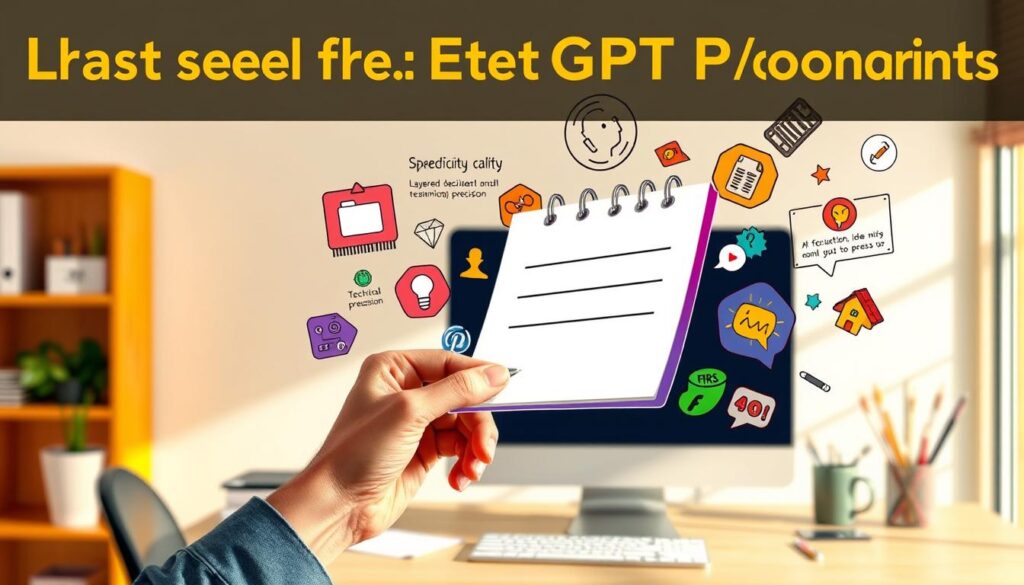Artificial intelligence tools like ChatGPT have transformed how we create content and solve problems. However, the quality of the results depends heavily on how you structure your prompts. A well-crafted prompt can unlock the full potential of these tools, while vague instructions may lead to disappointing outcomes.
ChatGPT, powered by OpenAI’s GPT-4o and Claude 3.5 Sonnet, is a game-changer in industries like marketing, healthcare, and education. Yet, it’s essential to remember its limitations. The model is trained on data up to late 2021, and its responses may require fact-checking. Additionally, there’s a risk of hallucinations, where the AI generates inaccurate or fabricated information.
This guide will help you master the art of writing effective prompts. Whether you’re a beginner or an experienced user, understanding these techniques will ensure you get the most out of your interactions with AI.
Key Takeaways
- Detailed prompts lead to higher-quality AI responses.
- ChatGPT’s training data is current up to late 2021.
- Fact-checking is essential to avoid inaccuracies.
- AI advancements like GPT-4o enhance performance.
- Industries like marketing and healthcare benefit from AI tools.
Introduction to ChatGPT Prompts
Crafting the right instructions for AI tools can make or break your results. These instructions, often called prompts, act as conversation starters for the language model. They guide the AI to generate the desired response, making them a critical part of the process.
Not all prompts are created equal. A basic query like “Write a poem” may yield generic results. On the other hand, a well-engineered prompt such as “Compose a sonnet about quantum computing in iambic pentameter” can produce highly specific and creative outcomes. The difference lies in the level of detail and clarity.

According to recent data, 63% of professionals use AI tools weekly for content creation. This highlights the growing importance of mastering prompt engineering. Tools like Chatsonic further enhance this process by offering real-time data capabilities, ensuring users get up-to-date and accurate information.
Here’s why engineered prompts matter:
- They lead to higher-quality AI-generated content.
- They save time by reducing the need for revisions.
- They unlock the full potential of advanced AI models.
Understanding the basics of prompts is the first step toward leveraging AI effectively. Whether you’re a beginner or an experienced user, refining your approach can significantly improve your results.
Understanding the Basics of ChatGPT Prompts
To get the best results from AI, understanding how it processes your input is crucial. The model behind tools like ChatGPT relies on a token-based system to interpret and generate responses. Each word or phrase is broken into tokens, which the AI uses to predict the next logical sequence. This system allows it to handle complex instructions efficiently.
Two key parameters influence the AI’s output: temperature and top-p sampling. Temperature controls the randomness of the response, while top-p sampling narrows down the selection of tokens. Adjusting these settings can help tailor the results to your needs.

For instance, Anthropic’s Constitutional AI takes a different approach by focusing on ethical guidelines. This ensures the responses align with predefined principles, reducing the risk of harmful or biased outputs. Comparing these methods highlights the importance of choosing the right model for your tasks.
A common mistake is using overly vague instructions. For example, asking “Write something about marketing” will likely yield generic results. Instead, specify the topic, tone, and format for better outcomes.
Here’s an interactive exercise: Take a weak prompt like “Explain AI” and rewrite it using the SPECIFIC framework. A stronger version could be, “Explain how AI transforms healthcare with three real-world examples.” This approach ensures clarity and precision.
| Parameter | Function | Impact on Output |
|---|---|---|
| Temperature | Controls randomness | Higher values increase creativity |
| Top-p Sampling | Narrows token selection | Focuses on most relevant options |
The Art of Crafting Effective Prompts
Mastering the skill of creating structured instructions can significantly enhance your AI interactions. A study by Writesonic found that 73% of users experienced improved results when using well-designed prompts. This section dives into the principles of clarity, specificity, and context to help you craft effective prompts.

Clarity and Specificity
Clear and specific instructions are the foundation of successful AI interactions. For instance, compare “Write about SEO” with “Act as an SEO expert with 10 years of experience and explain the top three ranking factors in 2023.” The latter provides context and detail, leading to more precise results.
Use the 5-part formula to structure your prompts: Role + Task + Format + Constraints + Examples. This approach ensures the AI understands your expectations and delivers high-quality responses.
Context and Detail
Adding context and detail can transform generic outputs into tailored solutions. For example, industry-specific templates for healthcare, legal, and tech sectors provide the AI with the necessary background to generate relevant content.
Integrating tools like Ahrefs for data-backed responses further enhances accuracy. However, avoid mixing multiple objectives in a single prompt, as this can confuse the AI and lead to subpar results.
“The quality of your instructions directly impacts the quality of the AI’s output. Always aim for clarity and precision.”
By focusing on these principles, you can unlock the full potential of AI tools and achieve your desired outcomes.
ChatGPT Prompt Engineering Techniques
Optimizing your approach to AI interactions can lead to better results. Structured techniques in crafting instructions ensure higher-quality outputs. According to HubSpot, using engineered prompts can boost productivity by 40%. This section explores actionable strategies to enhance your AI communication.
Using Action-Oriented Language
Action-oriented language is a cornerstone of effective prompt engineering. Start your instructions with strong verbs like “Generate,” “Analyze,” or “Compare.” This approach directs the AI to focus on specific tasks, improving the clarity of its responses.
For example, instead of saying “Tell me about marketing,” use “Analyze the top three marketing trends in 2023.” This step ensures the AI understands your expectations and delivers actionable insights.
Incorporating Examples
Adding examples to your prompts can significantly enhance the AI’s output. For instance, when creating a social media calendar, provide a template or sample post. This gives the AI a clear framework to follow.
Advanced techniques like recursive prompting allow for multi-stage tasks. Start with a broad instruction, then refine it based on the AI’s initial response. This iterative process ensures detailed and accurate results.

| Prompt Type | Example | Result Quality |
|---|---|---|
| Basic | “Write about SEO” | Generic, lacks depth |
| Engineered | “Act as an SEO expert and explain the top three ranking factors in 2023” | Detailed, actionable insights |
Key strategies to master prompt engineering:
- Use the VERB-first methodology: Generate, Analyze, Compare, Synthesize.
- Apply the template: “Act as [role] to [action] for [audience] achieving [metric].”
- Experiment with recursive prompting for complex tasks.
By implementing these techniques, you can unlock the full potential of AI tools. For more examples, check out these mind-blowing prompts to get started.
100 ChatGPT Prompts Examples
Exploring creative and practical uses of AI can unlock endless possibilities for various industries. Whether you’re looking to have fun, create engaging content, or advance your career, well-crafted instructions can make all the difference. Below, we’ve compiled a comprehensive list of prompts to inspire your next AI interaction.

Prompts for Fun
AI isn’t just for serious tasks—it can also bring joy and creativity to your day. Try these prompts for a bit of fun:
- “Write a short story about a time-traveling cat.”
- “Generate a list of 10 puns about coffee.”
- “Create a poem about the changing seasons.”
Prompts for Content Creation
Need fresh ideas for your blog or social media? These prompts can help:
- “Generate 5 scroll-stopping TikTok hooks about [product].”
- “Write a 500-word blog post on the benefits of remote work.”
- “Create an engaging email subject line for a summer sale.”
Prompts for Career Development
Advance your professional journey with these career-focused prompts:
- “Draft a cover letter for a software engineering position.”
- “Provide tips for negotiating a salary increase.”
- “Create a 30-day plan to improve leadership skills.”
Prompts for Education
Enhance learning experiences with these educational prompts:
- “Explain the Pythagorean theorem with real-world examples.”
- “Create a study schedule for final exams.”
- “Summarize the key events of the American Revolution.”
Prompts for Healthcare and Wellbeing
AI can assist in promoting health and wellness. Try these prompts:
- “Create a 7-day meal plan for gestational diabetes patients.”
- “Suggest 5 mindfulness exercises for stress relief.”
- “Explain the benefits of regular exercise for mental health.”
Prompts for Travel and Tourism
Plan your next adventure with these travel-inspired prompts:
- “Generate a 3-day itinerary for a trip to Paris.”
- “List 10 must-visit destinations in Japan.”
- “Provide tips for packing light for a week-long trip.”
Prompts for Web Development
For tech enthusiasts, these prompts can streamline your workflow:
- “Debug this Python code using PEP8 standards [paste code].”
- “Explain the difference between HTTP and HTTPS.”
- “Create a responsive design checklist for a new website.”
Prompts for Music
Unleash your inner musician with these creative prompts:
- “Compose a melody in the key of C major.”
- “Write lyrics for a song about overcoming challenges.”
- “Explain the basics of music theory for beginners.”
Prompts for Gaming
Gamers can use these prompts to enhance their experience:
- “Design a character backstory for an RPG game.”
- “Suggest 5 strategies for winning in Fortnite.”
- “Create a list of 10 unique game mechanics.”
With these prompts, you can explore the full potential of AI across various fields. Whether you’re crafting content, advancing your career, or simply having fun, the right instructions can lead to incredible results.
ChatGPT Prompt Limitations
While AI tools offer incredible capabilities, they come with certain limitations that users must be aware of. Understanding these constraints ensures better results and prevents potential pitfalls.

Data Limitations
One of the primary challenges is the data cutoff. AI models like ChatGPT are trained on information up to January 2022. This means they lack knowledge of events, trends, or updates after that date.
For example, asking for COVID-19 statistics might yield outdated figures. A case study revealed discrepancies in pandemic-related responses due to this temporal gap. Always verify such information with up-to-date sources like Google Scholar or Semrush.
Accuracy and Verification
Accuracy is another concern. AI models can sometimes generate incorrect or fabricated responses, known as hallucinations. Studies show that hallucination rates vary across different model versions.
To mitigate this, adopt a verification workflow. Cross-check AI-generated content with reliable sources. Combining human expertise with AI outputs can significantly improve accuracy.
“AI tools are powerful, but they are not infallible. Always verify critical information to ensure reliability.”
| Model Version | Hallucination Rate | Mitigation Strategy |
|---|---|---|
| GPT-3 | 15% | Hybrid human-AI editing |
| GPT-4 | 10% | Advanced verification workflows |
Here are some best practices to handle these limitations:
- Use AI outputs as a starting point, not the final answer.
- Cross-check critical data with trusted sources.
- Combine AI tools with human expertise for better results.
Tips for Writing Effective ChatGPT Prompts
Improving your AI interactions starts with refining your approach to crafting instructions. Whether you’re new to AI or a seasoned user, these tips will help you get better results. A study shows that 92% of successful users employ iterative prompting, meaning they test and tweak their instructions multiple times.

Experiment with Different Instructions
One of the best ways to improve your results is to experiment. Try the 3X Rule: create three variations of your instruction to see which one works best. This approach helps you identify the most effective phrasing and structure.
For example, if you’re asking for a blog post, try different tones or angles. You might ask for a formal article, a casual piece, and a listicle. Comparing the outputs will give you a clearer idea of what works for your needs.
Specify Response Length and Tone
Clarity is key when working with AI. Always specify the desired length and tone of the response. For instance, instead of saying “Write about marketing,” try “Write a 300-word article in a professional tone about digital marketing trends.”
Advanced parameters like max_tokens=1500 and temperature=0.7 can further refine the output. These settings control the length and creativity of the response, ensuring it meets your expectations.
| Parameter | Function | Recommended Value |
|---|---|---|
| max_tokens | Controls response length | 1500 |
| temperature | Adjusts creativity | 0.7 |
Here are some additional tips to optimize your instructions:
- Use voice consistency techniques to maintain a uniform tone across multiple outputs.
- Refer to real-world examples, like Hootsuite’s AI content workflow, for inspiration.
- Download a prompt optimization checklist to streamline your process.
By following these strategies, you can save time and achieve higher-quality results. Remember, the right language and structure can make all the difference in your AI interactions.
Advanced ChatGPT Prompt Strategies
Taking your AI interactions to the next level requires advanced strategies tailored to your goals. Whether you’re aiming to grow your business or enhance your content marketing, these techniques can help you achieve measurable results. Companies leveraging these methods report 35% faster content production, giving them a competitive edge.

Using AI for Business Growth
AI can transform how you approach business development. Start with automated competitive analysis using tools like SimilarWeb. This allows you to gather insights on market trends and competitor strategies without manual effort.
Another effective step is multi-platform repurposing. Create one detailed instruction, and use it to generate content for blogs, social media, and email campaigns. This approach saves time while maintaining consistency across channels.
For enterprises, implementing AI solutions like Salesforce’s Einstein GPT can streamline workflows and improve decision-making. Ensure compliance with industry regulations by integrating a framework tailored to your sector.
Leveraging AI for Content Marketing
Content marketing thrives on efficiency and creativity. Use AI to calculate ROI by estimating savings from automated content creation. This helps you allocate resources effectively and measure the impact of your efforts.
Focus on creating high-quality product descriptions, blog posts, and social media updates. By refining your instructions, you can generate engaging content that resonates with your audience.
Here are some key points to remember:
- Automate repetitive tasks to free up time for strategic planning.
- Use AI to analyze data and identify content gaps.
- Experiment with different formats to keep your audience engaged.
By adopting these advanced strategies, you can unlock the full potential of AI and drive meaningful results for your business.
Conclusion
Mastering AI interactions requires a blend of strategy and creativity. By following the SPECIFIC framework, you can craft instructions that deliver precise and actionable results. This approach ensures clarity and maximizes the potential of the model.
Looking ahead, emerging trends like voice-based prompting and AR integration are shaping the future of AI. Staying updated with these advancements will keep you ahead in the game. To get started, test these five must-try instructions for immediate results.
For those eager to deepen their knowledge, the IBM AI Engineering certification offers a comprehensive learning path. Ready to take your skills to the next level? Try the Chatsonic free trial with premium templates today.

